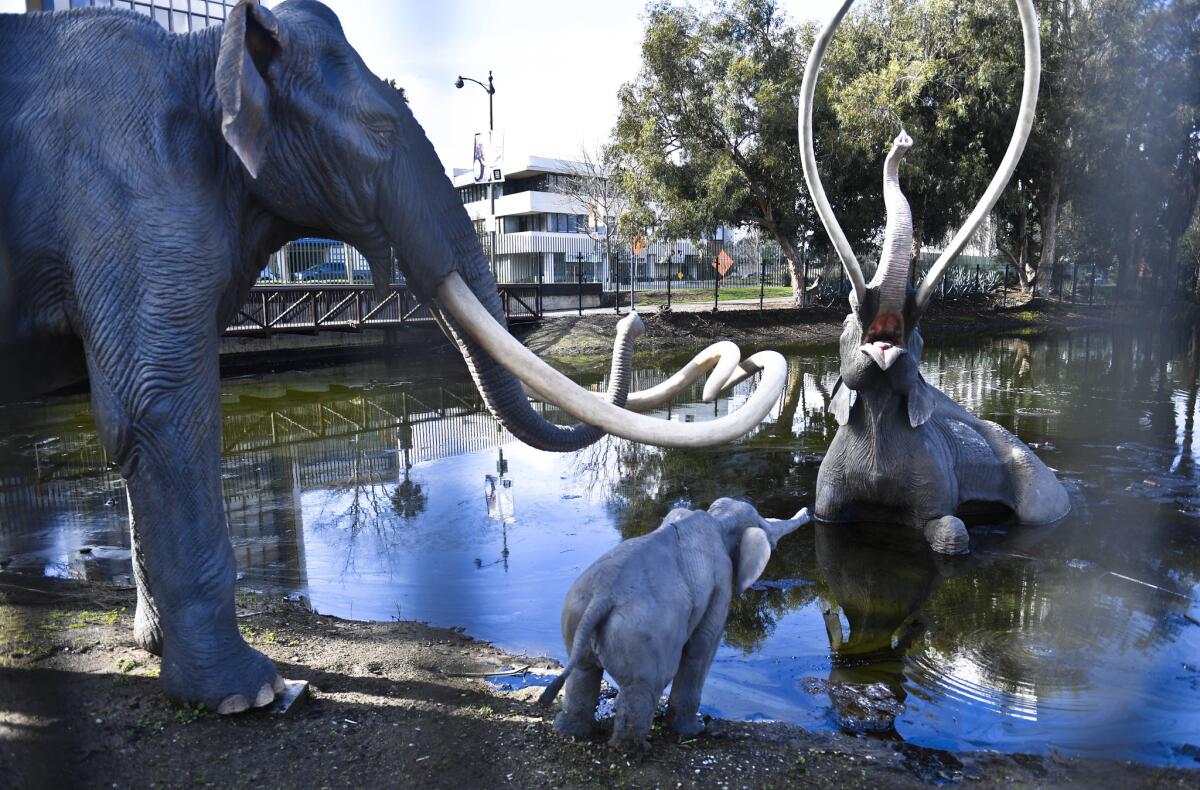Opinion: Don’t move the mammoths at La Brea Tar Pits

- Share via
My favorite photograph of the La Brea Tar Pits was taken in 1910, before it was in any way recognizable as what it would become. In the foreground, not far from what is now Wilshire Boulevard, a cluster of men stand in front of a small tar pond. Behind them, oil derricks rise against the backdrop of the Hollywood Hills.
There is no George C. Page Museum in this image, no LACMA, no city infrastructure of any kind. Even the tar pits, at least in shapes we might recognize, are nowhere to be seen. The photograph is a reminder of how conditional Los Angeles is, how malleable and in flux.
I’ve spent a fair amount of time thinking about this image in the five weeks since the unveiling of three proposals for renovating the tar pits and the Page Museum. Much of the response to the plans has revolved — anxiously — around the family of fiberglass mammoths that have played out a kitschy life-and-death drama for more than half a century along the shore of the Lake Pit at the corner of Wilshire and Curson. One redesign would relocate them indoors.
I share the consternation of many Angelenos; I don’t want the mammoths moved. I’ll admit I don’t like change in general, but I think the desire to keep the mammoths where they are points to something deeper too. The trio is a perfect example of Los Angeles’ conflicted identity: It both effaces and embraces history.
Early paleontological excavations at Rancho La Brea, from 1913 to 1915, established the narrative at the Lake Pit, which is a remnant of an asphalt mining operation. Tar seeps, disguised by fallen leaves, dust or water, trapped unwary Ice Age animals: dire wolves, ground sloths, saber-toothed cats and, yes, mammoths.
The fiberglass mammoth family is meant to trigger our most sentimental impulses. It’s a melodrama in three dimensions: One creature stuck and bellowing, two others — including a baby — in distress on the shore. But the context isn’t wrong. The appropriate fossils have been pulled from the tar, and the Page Museum has the dark-stained remains that prove it. The tableau is entertaining fakery, reconstituted history and a science lesson all rolled into one.
If that’s not enough reason to keep them in place, consider the juxtaposition of the tar and the tableau with the 21st century business and bustle barely a hundred yards away, outside the park. It’s a vivid a reminder of the dichotomy between geologic and human time.
Balancing that divide drives the mission of the Page Museum, which, Lori Bettison-Varga, president and director of the Natural History Museums of Los Angeles County, told me recently, “is one of the few museums in the world that has to be where it is.” What she’s referring to is the Page’s ongoing work of fossil excavation and preparation. When you visit the tar pits, you can see excavators digging in Pit 91 and scientists behind glass in the Fossil Lab, refining history and science in real time.
The Page Museum opened in 1977 and has never been renovated. I don’t doubt an upgrade is required. Of the three proposals under consideration, I favor the least intrusive, by the New York architecture firm of Weiss/Manfredi. It would preserve the basic footprint of the current museum while also enlarging the exhibition space. And it would keep the mammoths where they are.
Bettison-Varga stresses that “the three approaches are conceptual and not set in stone.” The museum has posted the plans online along with a public survey; the administrators promise “to embrace the community and take its feedback seriously.” So far, something in the range of 1700 responses have been delivered. Bettison-Varga calls them “generally positive” but declines to be more specific until the survey closes, Monday.
I was 6 when I first encountered the mammoths, the lake of tar and the seeps that dot Hancock Park. It was 1968, the year the installation of the tableau was completed, although I wasn’t aware of that at the time. All I knew was the awe I felt. I recollect it whenever I see them. The memory helps root me to this place.
In a city like Los Angeles, accommodating the mammoths just seems right. In their own way, they are relics of a kind. They signify the long arc that separates geologic time and 1968 aesthetics, a geochronological epoch and our compressed, human lifespans. Not only that, they also represent a Los Angeles specialty: the authentic and the artificial, inextricably linked.
David L. Ulin is a contributing writer to Opinion.
More to Read
A cure for the common opinion
Get thought-provoking perspectives with our weekly newsletter.
You may occasionally receive promotional content from the Los Angeles Times.










